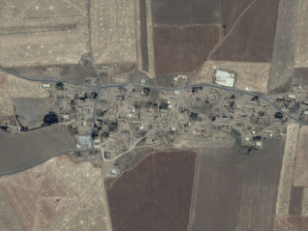‘We had nowhere else to go’: Forced displacement and demolitions in northern Syria reveals evidence of alarming abuses, including eyewitness accounts and satellite images, detailing the deliberate displacement of thousands of civilians and the razing of entire villages in areas under the control of the Autonomous Administration, often in retaliation for residents’ perceived sympathies with, or ties to, members of IS or other armed groups.
“By deliberately demolishing civilian homes, in some cases razing and burning entire villages, displacing their inhabitants with no justifiable military grounds, the Autonomous Administration is abusing its authority and brazenly flouting international humanitarian law, in attacks that amount to war crimes,” said Lama Fakih, Senior Crisis Advisor at Amnesty International.
“In its fight against IS, the Autonomous Administration appears to be trampling all over the rights of civilians who are caught in the middle. We saw extensive displacement and destruction that did not occur as a result of fighting. This report uncovers clear evidence of a deliberate, co-ordinated campaign of collective punishment of civilians in villages previously captured by IS, or where a small minority were suspected of supporting the group.” Some civilians said they were threatened with US-led coalition airstrikes if they failed to leave.
Satellite images obtained by Amnesty International illustrate the scale of the demolitions in Husseiniya village, in Tel Hamees countryside. The images show 225 buildings standing in June 2014 but only 14 remaining in June 2015 – a shocking reduction of 93.8%.
In February 2015, the Autonomous Administration’s military wing, the YPG (the People’s Protection Units), took control of the area, which had been under IS control, and began demolitions, displacing villagers. Researchers visiting Husseiniya saw ruins of destroyed homes and interviewed eyewitnesses.
“They pulled us out of our homes and began burning the home… they brought the bulldozers... They demolished home after home until the entire village was destroyed,” said one witness.
In villages south of the town of Suluk, some residents said YPG fighters had accused them of supporting IS and threatened to shoot them if they did not leave. While in some cases residents acknowledged that there had been a handful of IS supporters in their villages the majority were not supporters of the group.
In other cases, villagers said YPG fighters had ordered them to leave threatening them with US coalition airstrikes if they failed to comply.
“They told us we had to leave or they would tell the US coalition that we were terrorists and their planes would hit us and our families,” said one resident, Safwan.
The YPG has justified the forced displacement of civilians by saying it was necessary for the civilians’ own protection or militarily necessary.
It is critical that the US-led coalition fighting IS in Syria and all other states supporting the Autonomous Administration, or co-ordinating with it militarily, do not turn a blind eye to such abuses.
Lama Fakih
In one particularly vicious attack, YPG fighters poured petrol on a house, threatening to set it alight while the inhabitants were still inside.
“They started pouring fuel in my in-laws’ house. My mother-in-law was there refusing to leave and they just poured it around her…They found my father-in-law and began hitting him on his hands… I said, ‘Even if you burn my house I will get a tent and pitch it.This is in my place. I will stay in my place,” said Bassma.
Although the majority of residents affected by these unlawful practices are Arabs and Turkmen, in some cases, for example in the mixed town of Suluk, Kurdish residents have also been barred by the YPG and Asayish, the Autonomous Administration’s police force, from returning to their homes. Elsewhere, for example in Abdi Koy village, a small number of Kurdish residents have also been forcibly displaced by the YPG.
In an interview with Amnesty International, the head of the Asayish admitted civilians had been forcibly displaced but dismissed these as “isolated incidents”. The spokesperson for the YPG repeated claims that civilians were being moved for their own security.
However, many residents said they were forced to leave even though their villages had not been the site of clashes, or were at a distance from the frontline and there was no danger from improvised explosive devices (IEDs) laid by IS. Forcibly displacing civilians without imperative military necessity is a violation of international humanitarian law.
“The Autonomous Administration must immediately stop the unlawful demolition of civilian homes, compensate all civilians whose homes were unlawfully destroyed, cease unlawful forced displacements, and allow civilians to return and rebuild,” said Lama Fakih.
View article here




 RSS Feed
RSS Feed